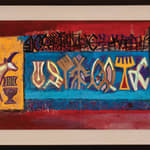Open a larger version of the following image in a popup:
 Seal with Two-Horned Bull and Inscription, c. 2000 BC. Pakistan, Indus Valley civilization
The Cleveland Museum of Art, USA
Seal with Two-Horned Bull and Inscription, c. 2000 BC. Pakistan, Indus Valley civilization
The Cleveland Museum of Art, USA
 Seal with Two-Horned Bull and Inscription, c. 2000 BC. Pakistan, Indus Valley civilization
The Cleveland Museum of Art, USA
Seal with Two-Horned Bull and Inscription, c. 2000 BC. Pakistan, Indus Valley civilization
The Cleveland Museum of Art, USA
Open a larger version of the following image in a popup:
 Shakir Ali, Still Life, 1955
Shakir Ali, Still Life, 1955
 Shakir Ali, Still Life, 1955
Shakir Ali, Still Life, 1955
Zahoor ul-Akhlaq
Untitled (Bull and Line of Figures), circa 1960
Gouache on paper
37.3 x 100.4 cm
14 3/4 x 39 1/2 in
14 3/4 x 39 1/2 in
Signed indistinctly lower right
Further images
Born in Delhi in 1941, Zahoor’s family moved to Lahore after the Independence of Pakistan in 1947, later settling in Karachi. He attended the Mayo School of Arts and was...
Born in Delhi in 1941, Zahoor’s family moved to Lahore after the Independence of Pakistan in 1947, later settling in Karachi. He attended the Mayo School of Arts and was taught by Shakir Ali. In this early painting by Zahoor, almost certainly from his time at the Mayo School, he uses the script and imagery of the Indus Valley Civilisation as his main visual tools. The painting is in essence a deconstructed Indus seal, with the central area of the painting representing a line of script, abstracted to the point of appearing almost as a still life, floating on a blue background. The panels at either end with figurative representations of a bull and of a standing female figure.
The composition of this work echoes the visual methods employed by Shakir Ali during the late 1950s/early 1960; of flat areas of colour and ornament overlapping and floating above one another, to produce what Akbar Naqvi describes as; ‘the joyous improvisations of a Cubist who had found the true meaning of space.’ Zahoor was soon to move away from the ‘modernist’ style he explored at the Mayo School, later shifting his focus towards the deconstruction and re-appropriation of imagery from classical miniature painting, in turn, becoming one of the most revered and influential Pakistani artists of the late 20th century.
Salima Hashmi comments; "Arguably the most significant Pakistani artist of our times, Zahoor unravelled complex questions of meaning embedded in tradition. He was concerned with the marginalized networks, practices and forms which still lurked beneath the surface offering up memories beyond the colonial. Zahoor ul Akhlaq was never content with facile readings of the 'Islamic' in his heritage."
The composition of this work echoes the visual methods employed by Shakir Ali during the late 1950s/early 1960; of flat areas of colour and ornament overlapping and floating above one another, to produce what Akbar Naqvi describes as; ‘the joyous improvisations of a Cubist who had found the true meaning of space.’ Zahoor was soon to move away from the ‘modernist’ style he explored at the Mayo School, later shifting his focus towards the deconstruction and re-appropriation of imagery from classical miniature painting, in turn, becoming one of the most revered and influential Pakistani artists of the late 20th century.
Salima Hashmi comments; "Arguably the most significant Pakistani artist of our times, Zahoor unravelled complex questions of meaning embedded in tradition. He was concerned with the marginalized networks, practices and forms which still lurked beneath the surface offering up memories beyond the colonial. Zahoor ul Akhlaq was never content with facile readings of the 'Islamic' in his heritage."

















